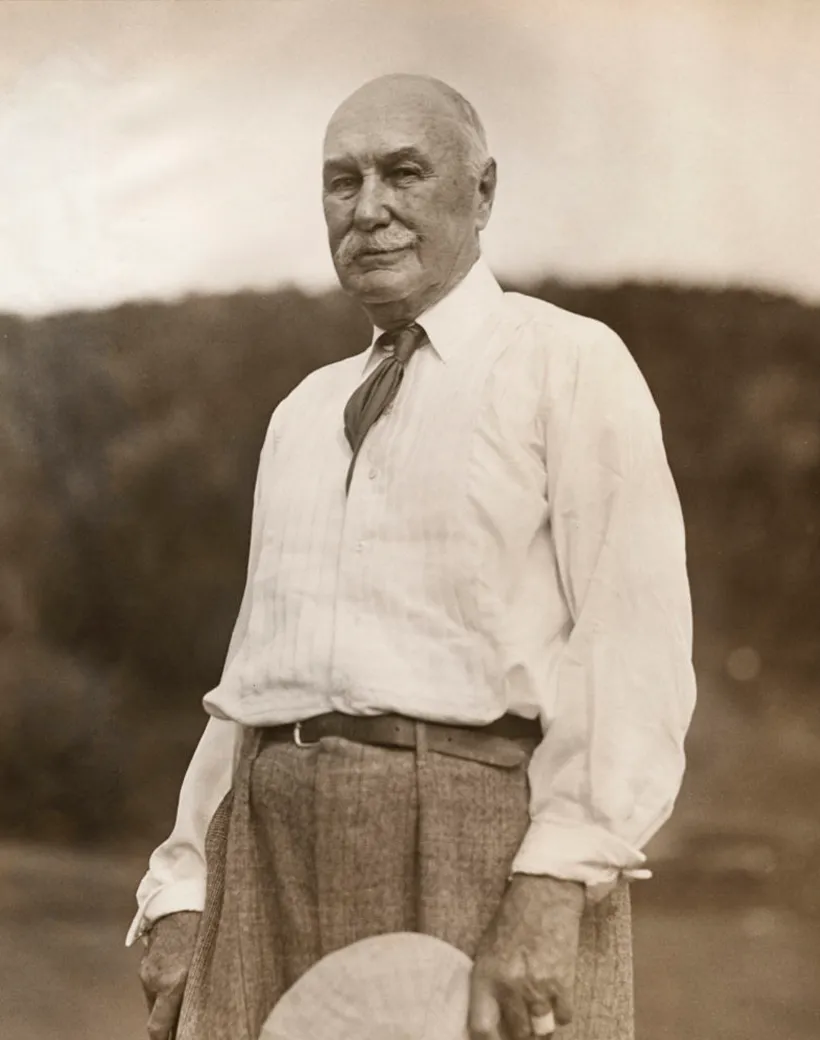C.B. Macdonald
A towering influence on the development of American golf architecture and the creator of National Golf Links of America and The Lido. His notion of "ideal holes" and invention of new construction methods had a revolutionary impact on the game.

November 14, 1855, Niagara Falls, Ontario
April 21, 1939, Southampton, New York
The Ideal Holes of C.B. Macdonald
Golf Architecture 101: Template Holes
C.B. Macdonald's Ideal Holes: The Double Plateau Template
Charles Blair Macdonald was born in Niagara Falls, Ontario, to a Scottish father and a Canadian mother, before growing up in Chicago during the Civil War and Reconstruction. In 1872, at age 16, he left to study at St. Andrews University in Scotland. Initially skeptical of the city’s main pastime, he soon discovered the charms of golf. He ended up challenging Old Tom Morris, Young Tom, and other elite St. Andrews golfers to frequent matches at the Old Course.
Upon returning to America in 1874, Macdonald was disappointed to find that the game had not yet taken off in the country. He founded Chicago Golf Club in 1892, which settled at its current location near Wheaton in 1894 with a Macdonald layout opening the following year. After challenging the legitimacy of two losses in experimental amateur championships conducted by the newly founded USGA in 1894, he won the inaugural U.S. Amateur in 1895 at Newport Country Club. In 1901, Macdonald was inspired by a discussion of the UK’s greatest holes in Golf Illustrated to conceive of an ideal golf course based on the best ideas and features found on the British links. In three trips across the Atlantic, he took notes on and drew diagrams of the architectural characteristics he wished to emulate in the U.S. He first put his “ideal holes” — also known as “template holes” — into practice at the National Golf Links of America on Long Island’s Great Peconic Bay.
Collaborating with local engineer Seth Raynor on construction, Macdonald finished NGLA in 1910. The course was immediately hailed as a masterpiece. Given its success, Macdonald was pressed by many New York-area elites to build golf courses over the next decade, at Piping Rock Club (1912), Sleepy Hollow Country Club (1914), The Lido (1918, NLE), Links Club (1919, NLE), and The Creek Club (1922). Increasingly, Macdonald delegated design and construction duties to Raynor. The pair completed projects at St. Louis Country Club (1914), Mid Ocean Club on Bermuda (1922), and The Course at Yale (1924), all fine examples of the MacRaynor style.
By the early 1920s, Macedonald had largely retired as an architect, although he continued to tweak his crowning achievement, the National, into his later years. In 1928, Macdonald finished his book Scotland’s Gift - Golf, which covers both his design philosophy and the history of golf from its inception in the United States. Notoriously stubborn, loquacious, and self-aggrandizing, Macdonald makes sure to emphasize his importance in that history. Still, there is no disputing his huge influence on golf architecture, with new template-inspired courses still being built today.
The Lido
While C.B. Macdonald’s recovered design at The Lido should—and likely will—be inspirational for many golf architects, the construction techniques behind it may prove even more influential
Chicago Golf Club
Chicago Golf Club is one of the most intelligently designed courses in America, featuring a world-class set of Seth Raynor green complexes
Chicago Golf Club
St. Louis Country Club
C.B. Macdonald's westernmost design is one of the most underrated golf courses in the country
St. Louis Country Club
The Creek
One of C.B. Macdonald’s final projects, The Creek weaves his "ideal holes" through three distinct environments on the North Shore of Long Island
National Golf Links of America
The success of C.B. Macdonald's National Golf Links created a showcase for what world-class golf architecture looked like in the U.S.
National Golf Links of America


Leave a comment or start a discussion
Engage in our content with thousands of other Fried Egg Golf Members
Engage in our content with thousands of other Fried Egg Golf Members
Get full access to exclusive benefits from Fried Egg Golf
- Member-only content
- Community discussions forums
- Member-only experiences and early access to events



























Leave a comment or start a discussion
Lorem ipsum dolor sit amet, consectetur adipiscing elit. Suspendisse varius enim in eros elementum tristique. Duis cursus, mi quis viverra ornare, eros dolor interdum nulla, ut commodo diam libero vitae erat. Aenean faucibus nibh et justo cursus id rutrum lorem imperdiet. Nunc ut sem vitae risus tristique posuere. uis cursus, mi quis viverra ornare, eros dolor interdum nulla, ut commodo diam libero vitae erat. Aenean faucibus nibh et justo cursus id rutrum lorem imperdiet. Nunc ut sem vitae risus tristique posuere.